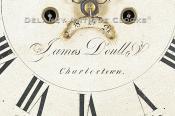James Doull of Charlestown, Massachusetts. A cross-banded mahogany case tall clock with a moon phase dial. PP-159.
This is a fine cross-banded mahogany tall case clock with a painted dial signed by James Doull of Charlestown, Massachusetts.
The colorfully painted 13-inch iron dial is of local origin and was most likely painted by the Boston ornamental artists Spencer Nolen & Samuel Curtis. Similar dials have been found signed on the back of the dial. This example is signed on the front by the clockmaker, "James Doull." The font is in a fancy script lettering that stretches across the dial's center. Doull's working location, "CHARLESTOWN," is written in a more reserved fashion and is positioned below the calendar. In the lunette of the dial, one will find the automated feature of a lunar calendar or a moon-phase mechanism. This is designed to track the phases of the moon or the lunar calendar. The lunar month cycle is approximately 29.5 days in length. The four spandrel areas are colorfully painted-decorated. The bright colors of red, yellow, and gold contrast nicely with one another. Raised gesso work is also used to shape some of the patterns. Large Roman numerals indicate the hours. The five-minute markers are indicated in an Arabic format. Subsidiary seconds dial, and a calendar is displayed in the traditional locations. The hands are nicely formed and filed from steel.
This cross-banded mahogany case exhibits excellent proportions. The base proudly stands on applied French feet. Please note the delicate shaping or flare and the wonderful height they provide. The line of the feet transitions gracefully into a double-drop apron. This treatment is separated from the base panel with a thin molding applied to the bottom of the base panel. The front panel of the base is framed with a narrow cross-banded border. This panel is veneered with a selection of mahogany that features long sweeping vertical lines. The waist is long and fitted with a large rectangular-shaped waist door trimmed with an applied molding. Positioned just inside this molding is a cross-banded framing. The front corners of the waist are fitted with reeded quarter columns. These terminate in brass quarter capitals. The bonnet features an open fretwork design that incorporates three reeded finial plinths. Each of these supports a single brass ball and spiked finial. Fully turned and reeded bonnet columns support the upper bonnet molding. Tombstone-shaped sidelights are fitted into the sides of the hood. The arched bonnet door is decoratively veneered. The door opening is fitted with glass.
This clock was made circa 1810 and stands approximately 8 feet tall.
This clock is inventory number PP-159.
James Doull was born in Scotland in 1785 and immigrated to the United States, Boston, in 1806 at the age of 29. In 1807, he was listed in the Boston tax records as working as a journeyman working for the Boston clockmaker Aaron Willard. This suggests that he came to this country already trained and highly skilled. Because he is listed for only one year in Boston, it is assumed he moved to Charlestown shortly after this date. In 1823, Doull moved to Pennsylvania and took up residence in Philadelphia. In this city, he is listed as having several addresses over the years. In 1823, he resided at 112 High. In 1825, Doull moved to No. 3 Castle. From 1828 through 1833, he was on the southeast corner of South and Spruce. From 1835 through 1849, he was at the southeast corner of 4th and Spruce. Lastly, in 1856, Doull moved to south 4th and stayed there until 1856.
Over the years, we have owned a dozen or more tall case clocks, several shelf clocks, and a small number of timepieces made by this fine and talented clockmaker. The vast majority of the known clocks to us were of Massachusetts origin. One tall clock with the place location signed "Philadelphia" is also known. James Doull's most famous clock is in the White House Collection in Washington, DC. This clock is frequently on display in the Oval Office. It features a signed painted dial and a case that is attributed to the Seymour Brothers cabinetmaking firm.












